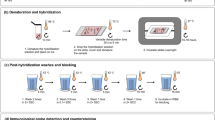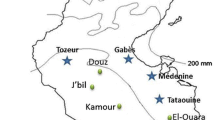Abstract
To investigate the genome of the aphidMegoura viciae at molecular level, we have studied total DNA by agarose gel electrophoresis after cleavage with different restriction endonucleases.EcoRI digestion produced a highly repeated DNA fragment, about 600 bp long. The contribution of thisEcoRI element to the total genome ofM. viciae was estimated at about 6% by means of densitometric scanning of agarose gel photographs. The chromosomal localization of this fragment, investigated by fluorescentin situ hybridization (FISH), constantly showed one large and two narrower fluorescent bands located on the X chromosome, all corresponding to C-positive heterochromatic areas. These results are in full accordance with the data obtained byin situ nick translation experiments carried out afterEcoRI digestion, and clearly demonstrate that a substantial amount ofM. viciae heterochromatin consists ofEcoRI fragments which are mainly located on the X chromosome. Using theEcoRI restriction fragment as a molecular probe may prove to be a practical tool for the investigation of taxonomic and evolutionary relationships in this group of insects.
Similar content being viewed by others
References
Beye M, Moritz RFA (1995) Characterization of honeybee (Apis mellifera L.) chromosomes using repetitive DNA probes and fluorochromein situ hybridization.J Heredity 86: 145–150.
Blackman, RL (1987) Reproduction, cytogenetics and development. In: Minsk AK, Harrewijn P, eds.Aphids: their Biology, Natural Enemies and Control, Vol. A. Amsterdam: Elsevier pp 163–195.
Burkholder GD (1989) Morphological and biochemical effects of endonucleases on isolated mammalian chromosomesin vitro.Chromosoma 97: 347–355.
Collet C, Westerman M (1984) Interspersed distribution patterns of C-bands and satellite DNA in the holocentric chromosomes ofLuzula flaccida (Juncaceae).Genetica 63: 175–179.
Davis CA, Wyatt GR (1989) Distribution and sequence homogeneity of an abundant satellite DNA in the beetle,Tenebrio molitor.Nucleic Acids Res 17: 5579–5586.
de La Torre J, Mitchell AR, Sumner AT (1991) Restriction endonuclease/nick translation of fixed mouse chromosomes: a study of factors affecting digestion of chromosomal DNAin situ.Chromosoma 100: 203–211.
de La Torre J, Sumner AT, Gosalvez J, Stuppia L (1992) The distribution of genes on human chromosomes as studied byin situ nick translation.Genome 35: 890–894.
Gosalvez J, Lopez-Fernandez C, Ferrucci L, Mezzanotte R (1989) DNA base composition is not the only factor for restriction endonuclease activity on metaphase chromosomes: evidences using isoschizomers.Cytogenet Cell Genet 50: 142–144.
Herrero P, de La Torre J, Arano B, Gosalvez J, Sumner AT (1995) Patterns of DNase sensitivity in the chromosomes ofRana perezi (Amphibia: Anura).Genome 38: 339–343.
Hughes-Schrader S, Schrader F (1961) The kinetocore of the Hemiptera.Chromosoma 12: 327–350.
John B, Miklos GLG (1979) Functional aspects of satellite DNA and heterochromatin.Int Rev Cytol 58: 1–114.
John B, Miklos GLG (1988)The Eukaryotic Genome in Development and Evolution. London: Allen & Unwin.
Lagowsky JM, Yu M-YW, Forrest HS, Laird CD (1973) Dispersity of repeat DNA sequences inOncopeltus fasciatus, an organism with diffuse centromeres.Chromosoma 43: 349–373.
Manicardi GC, Gautam DC (1994) Cytogenetic investigations on the holocentric chromosomes ofTetraneurella akinire (Sasaki) (Homoptera, Pemphigidae).Caryologia 47: 159–165.
Manicardi GC, Bizzaro D, Aloisi P et al. (1991a). New approaches to the study of aphid chromosomes. Proceedings of the 4th European Congress of Entomology, Vol. 1, Godollo, Hungary, September 1–6, 1991. Budapest: Hungarian Natural History Museum, pp 84–88.
Manicardi GC, Bizzaro D, Bonvicini Pagliai AM, Bianchi U (1991b) Characterization ofAcyrthosiphon pisum Harris (Homoptera: Aphididae) karyotype using G and C banding. Proceedings of the XVI Italian Congress of Entomology, Bari/Martina Franca, Italy, September 23–28, 1991. Bari: Industria Grafica Laterza, pp 513–517.
Manicardi GC, Gautam DC, Bizzaro D et al. (1991c) Chromosome banding in Aphids: G, C,AluI, andHaeIII banding patterns inMegoura viciae (Homoptera, Aphididae)Genome 34: 661–665.
Manicardi GC, Bizzaro D, Azzoni P, Bianchi U (1994) Cytological and electrophoretic analysis of DNA methylation in the holocentric chromosomes ofMegoura viciae (Homoptera, Aphididae)Genome 37: 625–630.
Manicardi GC, Bizzaro D, Galli E, Bianchi U (1996) Heterochromatin heterogeneity in the holocentric X chromatin ofMegoura viciae (Homoptera, Aphididae).Genome (in press).
Mezzanotte R, Ferrucci L, Vanni R, Sumner AT (1985) Some factors affecting the action of restriction endonucleases on human metaphase chromosomes.Exp Cell Res 161: 247–253.
Mezzanotte R, Rossino R, Nieddu M, Lopez-Fernandez C, Gosalvez J (1992) The DNA fragments produced byAluI andBstNI digestion of fixed mouse chromosomes.Chromosoma 101: 553–556.
Pignone D, Galasso I, Rossino R, Mezzanotte R (1995) Characterization ofDasypyrum villosum (L.) Candargy chromosomal chromatin by means ofin situ restriction endonucleases, fluorochromes, silver staining and C-banding.Chromosome Res 3: 109–114.
Singer MF (1982) Highly repeated sequences in mammalian genomes.Int Rev Cytol 76: 67–112.
Sumner AT (1972) A simple technique for demonstrating centromeric heterochromatin.Exp Cell Res 75: 304–306.
Sumner AT, Taggart MH, Mezzanotte R, Ferrucci L (1990) Patterns of digestion of human chromosomes by restriction endonucleases demonstrated byin situ nick translation.Histochem J 22: 639–652.
Ugarkovic D, Plhol M, Petitpierre E, Lucijanic-Justic V, Juan C (1994)Tenebrio obscurus satellite DNA is resistant to cleavage by restriction endonucleasein situ.Chromosome Res 2: 217–223.
Author information
Authors and Affiliations
Corresponding author
Additional information
accepted for publication by J. S. (Pat) Heslop-Harrison
Rights and permissions
About this article
Cite this article
Bizzaro, D., Manicardi, G.C. & Bianchi, U. Chromosomal localization of a highly repeatedEcoRI DNA fragment inMegoura viciae (Homoptera, Aphididae) by nick translation and fluorescencein situ hybridization. Chromosome Res 4, 392–396 (1996). https://doi.org/10.1007/BF02257275
Received:
Revised:
Accepted:
Issue Date:
DOI: https://doi.org/10.1007/BF02257275




